AMD Reveals More Llano Details at ISSCC: 32nm, Power Gating, 4-cores, Turbo?
by Anand Lal Shimpi on February 8, 2010 12:00 AM EST- Posted in
- CPUs
After cashing Intel’s check and appearing more competitive than expected against Clarkdale 2010 is like a fresh start for AMD. The news gets better.
Late last year AMD said that before the end of 2010 it would be sampling its first APU (Accelerated Processing Unit) - codenamed Llano. Today AMD is announcing that the first Llano samples, built on Global Foundries 32nm high-k + metal gate, SOI process will be sampling to partners in the first half of this year.
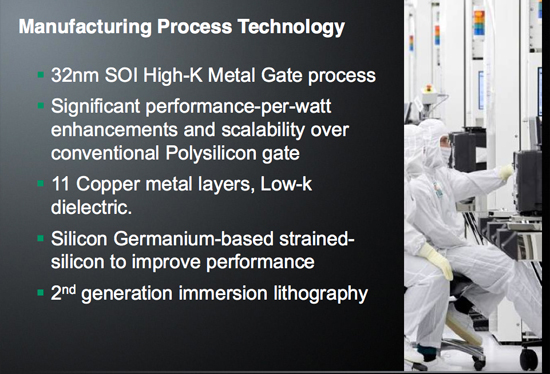
GF's 32nm SOI High-K + MG process will be used with Llano
For those not in the know, Llano is AMD’s first hybrid CPU-GPU with on-die graphics. The graphics core is a derivative of AMD’s DirectX 11 Evergreen lineup (the same lineage as the Radeon HD 5970, 5870, 5850, 5670, 5570, 5450, etc...).
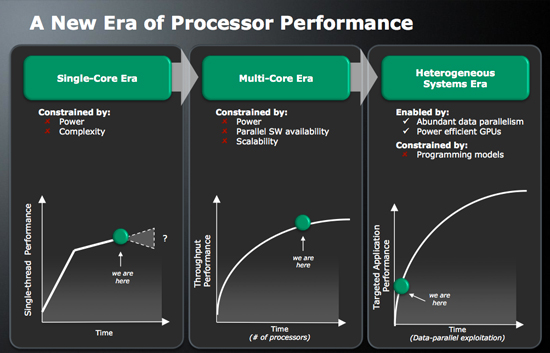
Llano will go up against Sandy Bridge, which seems to have been pushed back to 2011 for volume availability according to Intel’s internal roadmaps. While Sandy Bridge will have graphics on-die, it will still only be DX10 class - AMD will have the feature-set advantage as far as graphics is concerned.

Llano's Features
Today we learn a bit more about the CPU side of Llano. The first chip will be a quad-core processor plus on-die graphics. Each core is Phenom II derived, but there’s no shared L3 cache. So Llano cores look a lot like Athlon II cores. I’m hearing that they may have some architectural tweaks, so performance could be better than present-day Athlon IIs.
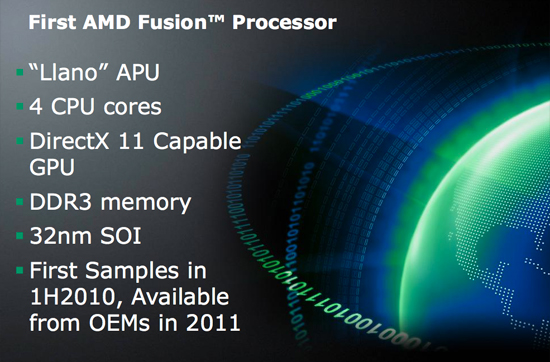
At 32nm each core (minus L2 cache) is only 9.69 mm^2 and is made up of over 35M transistors. Each core is paired with its own 1MB L2 cache, meaning the quad-core processor will have a total of 4MB of L2 on-die. AMD expects Llano to run at above 3GHz, which should be more than possible at 32nm given that we’re already at close to 3GHz with the 45nm Athlon II X4.

AMD’s First Power Gated CPU
With Nehalem Intel introduced power gating, a technique that allows a core to be near-completely powered down minimizing leakage current when inactive. This not only reduces idle power but it also enables Intel to use extra TDP to turbo up active cores.
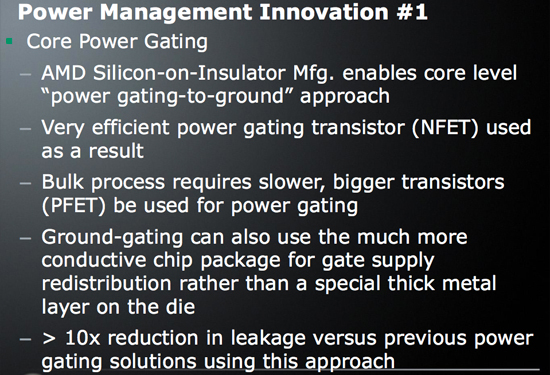
Llano uses power gating as well as a Digital APM Module. AMD doesn’t go into much detail on the digital APM module but I’m guessing we’ll see the same sort of turbo-like functionality out of Llano, including graphics turbo.
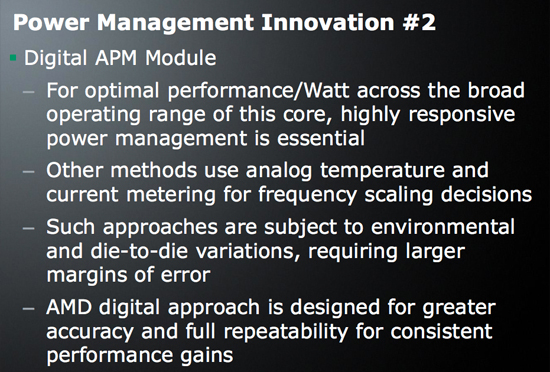
AMD also pointed out that Llano uses a “power aware clock grid design”. I couldn’t get much more information out of AMD on this one, other than its expecting a ~2x reduction in clock switching power. Simply distributing the clock to all parts of a modern day microprocessor can take up quite a bit of power, any improvements in efficiency there are very important.
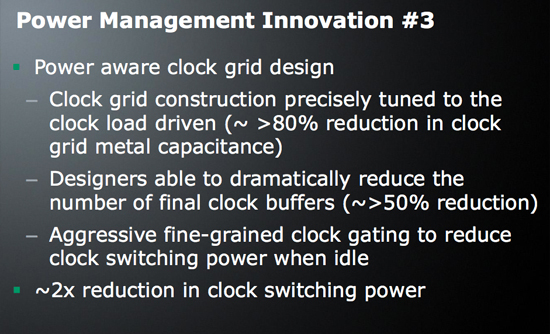
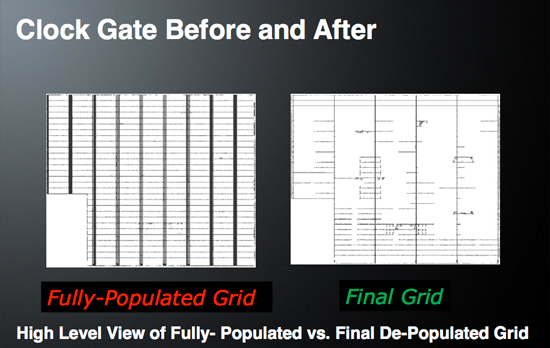
I’ll keep digging to see if I can get any more details on this aspect of Llano.
Final Words
Llano will obviously require a new socket. All AMD is saying is that OEMs will be shipping systems in 2011. It’s unclear if we’ll see anything in the channel before then, but with sampling in the coming months it appears that AMD could be ready for Sandy Bridge when it arrives next year.
AMD isn’t qualifying its 2011 statement with an indication of what quarter to expect systems. Given that the first samples are going out now, I’d expect to see Llano sometime in the first half of 2011 but that’s purely conjecture on my part. Sandy Bridge is scheduled to ship in volume in the first quarter of 2011.

The big questions going forward are 1) how much AMD and Intel are going to scale up its graphics performance on these chips, and 2) how important DX11 support will be to the upcoming APU race.










58 Comments
View All Comments
qwertymac93 - Monday, February 8, 2010 - link
they did need a new socket, what did you think socket 1156 was?GeorgeH - Monday, February 8, 2010 - link
Market segmentation?AM3 was only released ~6 months before 1156 (and not in 2006), so it doesn't seem entirely out of the question that AMD could have planned for video out just as easily as Intel did.
stlbearboy - Monday, February 8, 2010 - link
They could have, but then socket AM3 processors would not fit into Socket AM2+ boards. AM3 was designed to be backwards compatible with AM2. The question is will AMD at some point stop including IGP on their north bridges after the 800 series chipsets.Kiijibari - Monday, February 8, 2010 - link
Because intel already designed the 1156 socket for that purpose, it is just some month old.AMDs socket AM3 however is based on AM2 and that was already 4 years ago ... nobody thought about onchip graphics back then.
weilin - Monday, February 8, 2010 - link
It's very likely, when Intel overhauled their chipsets going from 775 to 1156 (Late 2009), they took into account the pins necessary for video whereas when AMD overhauled theirs from 939 to AM2/AM3 (~2006), this idea of fusion was just that... an idea...StevoLincolnite - Monday, February 8, 2010 - link
I personally think that the new processors will work in AM3 boards, however doing so would then deactivate the Graphics, AMD has enjoyed some great backwards compatibility as of late and it's a good selling point, so it wouldn't surprise me if they engineered a solution around it.Plus if you were going to throw this chip into an AM3 board chances are you have a Radeon 3xxx or higher IGP anyway, and the GPU on the CPU wouldn't be required in such a case. (Especially considering there is a substantial amount of boards with Side-port memory, why make that go to waste?)
I guess we have to do the waiting game for awhile yet for more details to emerge, but Currently I'm running an AM3 Athlon 2 620 in an ancient AM2 board (Not AM2+) and works a treat, if a new board is required for me to upgrade that system I wouldn't loose any sleep over it. :P
mesiah - Tuesday, February 9, 2010 - link
Buying this chip then disabling the gpu would totally defeat the purpose of the chip.Griswold - Tuesday, February 9, 2010 - link
You mean just like many are doing with the current clarkdales?mino - Saturday, February 13, 2010 - link
CPU vs. GPU usability :Clarkdale usability 10:1
Liano 10:5
Hope you get the picture. Clarkdale has just a on-package bundled G45 northbridge.
Liano is/will be a fully integrated design.
Jjoshua2 - Monday, February 8, 2010 - link
What I would like to know is if there is any advantage for the common user, and if there is any advantage for the common AT reader. I think common user is fine with atom that can play hulu, while AT reader wants games and is interested in CUDA projects like folding@home, while this help that?